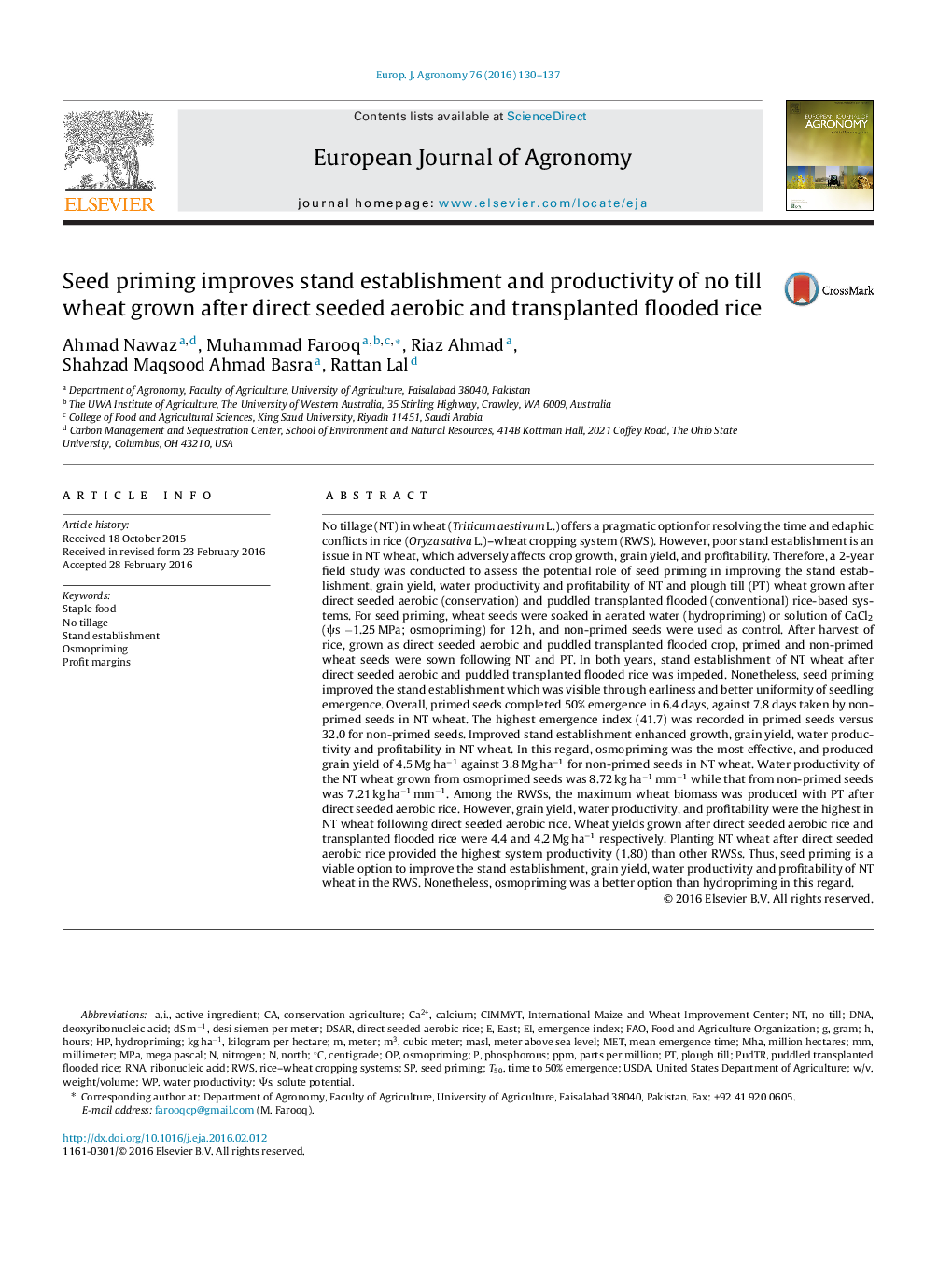| کد مقاله | کد نشریه | سال انتشار | مقاله انگلیسی | نسخه تمام متن |
|---|---|---|---|---|
| 6374263 | 1645594 | 2016 | 8 صفحه PDF | دانلود رایگان |
عنوان انگلیسی مقاله ISI
Seed priming improves stand establishment and productivity of no till wheat grown after direct seeded aerobic and transplanted flooded rice
ترجمه فارسی عنوان
بذر را بهبود می بخشد و بهره وری بدون گندم پس از رشد مستقیم بذر آروغ و برنج پر شده
دانلود مقاله + سفارش ترجمه
دانلود مقاله ISI انگلیسی
رایگان برای ایرانیان
کلمات کلیدی
t50METERUSDAHydroprimingRWSCIMMYTMPAMHAppmΨsa.i.International Maïze and Wheat Improvement Centercentigradecubic meterCa2+ - Ca2 +DNA - DNA یا اسید دزوکسی ریبونوکلئیکw/v - W / V°C - ° CStand establishment - استقرار پایهOsmopriming - اسموپریمینگdeoxyribonucleic acid - اسید deoxyribonucleicribonucleic acid - اسید ریبونوکلئیکRNA - اسید ریبونوکلئیکNo tillage - بدون خاکریزیseed priming - بذر بذرWater productivity - بهرهوری آبUnited States Department of Agriculture - دپارتمان کشاورزی ایالات متحدهFood and Agriculture Organization - سازمان غذا و کشاورزیhours - ساعت هاEAST - شرقNorth - شمالStaple food - غذای اصلیFAO - فائوPhosphorous - فسفرparts per million - قطعات در میلیونactive ingredient - ماده فعالMASL - ماسکMET - ملاقات کردmega pascal - مگا پاسکالMillimeter - میلیمترNo till - نه بهNitrogen - نیتروژنweight/volume - وزن / حجمconservation agriculture - کشاورزی حفاظتیCalcium - کلسیمGram - گرام
موضوعات مرتبط
علوم زیستی و بیوفناوری
علوم کشاورزی و بیولوژیک
علوم زراعت و اصلاح نباتات
چکیده انگلیسی
No tillage (NT) in wheat (Triticum aestivum L.) offers a pragmatic option for resolving the time and edaphic conflicts in rice (Oryza sativa L.)-wheat cropping system (RWS). However, poor stand establishment is an issue in NT wheat, which adversely affects crop growth, grain yield, and profitability. Therefore, a 2-year field study was conducted to assess the potential role of seed priming in improving the stand establishment, grain yield, water productivity and profitability of NT and plough till (PT) wheat grown after direct seeded aerobic (conservation) and puddled transplanted flooded (conventional) rice-based systems. For seed priming, wheat seeds were soaked in aerated water (hydropriming) or solution of CaCl2 (Ïs â1.25 MPa; osmopriming) for 12 h, and non-primed seeds were used as control. After harvest of rice, grown as direct seeded aerobic and puddled transplanted flooded crop, primed and non-primed wheat seeds were sown following NT and PT. In both years, stand establishment of NT wheat after direct seeded aerobic and puddled transplanted flooded rice was impeded. Nonetheless, seed priming improved the stand establishment which was visible through earliness and better uniformity of seedling emergence. Overall, primed seeds completed 50% emergence in 6.4 days, against 7.8 days taken by non-primed seeds in NT wheat. The highest emergence index (41.7) was recorded in primed seeds versus 32.0 for non-primed seeds. Improved stand establishment enhanced growth, grain yield, water productivity and profitability in NT wheat. In this regard, osmopriming was the most effective, and produced grain yield of 4.5 Mg haâ1 against 3.8 Mg haâ1 for non-primed seeds in NT wheat. Water productivity of the NT wheat grown from osmoprimed seeds was 8.72 kg haâ1 mmâ1 while that from non-primed seeds was 7.21 kg haâ1 mmâ1. Among the RWSs, the maximum wheat biomass was produced with PT after direct seeded aerobic rice. However, grain yield, water productivity, and profitability were the highest in NT wheat following direct seeded aerobic rice. Wheat yields grown after direct seeded aerobic rice and transplanted flooded rice were 4.4 and 4.2 Mg haâ1 respectively. Planting NT wheat after direct seeded aerobic rice provided the highest system productivity (1.80) than other RWSs. Thus, seed priming is a viable option to improve the stand establishment, grain yield, water productivity and profitability of NT wheat in the RWS. Nonetheless, osmopriming was a better option than hydropriming in this regard.
ناشر
Database: Elsevier - ScienceDirect (ساینس دایرکت)
Journal: European Journal of Agronomy - Volume 76, May 2016, Pages 130-137
Journal: European Journal of Agronomy - Volume 76, May 2016, Pages 130-137
نویسندگان
Ahmad Nawaz, Muhammad Farooq, Riaz Ahmad, Shahzad Maqsood Ahmad Basra, Rattan Lal,
